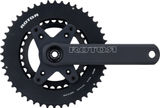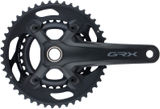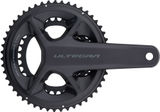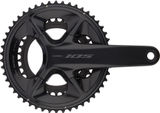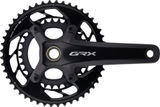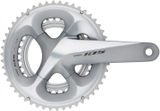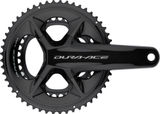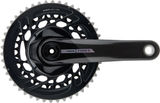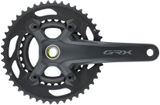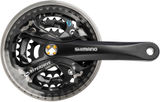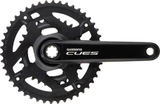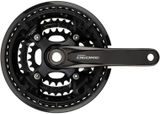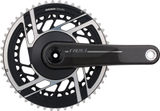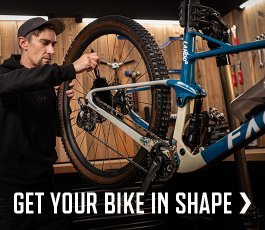Cranks
OUR Cranks RECOMMANDATIONS
Our Suggestions
Historically, it was the pedal crank that made the bicycle the efficient machine it remains today. Cranks are used to apply power to climb mountains. On the descent back down to the valley, the pedal arms offer you a secure foothold and, especially on the MTB, you also give important riding impulses via the crank. If you want to buy new cranks for your bike, you should consider a few aspects. Below you will find tips to help you find the right crankset. Read further and discover more.
Which bike crank do I need?
When looking for the right crankset for your bike, there are a few factors to consider. MTB and road bike cranks should be compatible with your gears and bottom bracket. E-bike cranks must also match the mid-mounted motor. The length of the crank arms and the Q-factor are important for ergonomics, while the material issue is reflected in weight, stiffness and price. In our range you will find suitable cranks from top brands such as Shimano , SRAM, Truvativ, Rotor, e*thirteen, Race Face, Campagnolo and Praxis Works. Our filters will help you to narrow down your selection in our shop.
Select a Crank and Chainring to Match the Gears
Even though you can change the chainrings on most cranks, we recommend that you consider the gears when buying the crankset. Use our shop filters to select cranks with chainrings for a certain number of gears. There are the number of chainrings ("crank gearing") and the number of sprockets of your cassette on the rear wheel ("chain gearing"). The latter is important because if you are riding a twelve-speed drivetrain, the pre-installed chainring on the crank must fit the narrow chain. For cranks with classic mounting of the chainrings on a spider, the bolt circle diameter determines which chainrings fit. A compact crank for road bikes, for example, allows smaller chainrings and thus a lighter gear ratio. Also pay attention to the number of holes for chainring bolts. Some bolt circle diameters come as four and five arm spiders and the two are not compatible. Here the filter "assembly" helps you, which covers this aspect in addition to various direct mount chainrings. Some cranks are not supplied with chainrings. The product descriptions reveal everything important about what’s included in the box. You will find the matching direct mount chainring in the corresponding shop category.
Crankset, Bottom Bracket and Chainline
To ensure that your new crank fits your bottom bracket, you should consider the type and diameter of the crank axle. On most modern bikes, it is part of the crankset and is simply inserted through the bottom bracket. To find out which diameter fits your bottom bracket, you can simply measure the axle of your old crank or look for a data sheet. In the shop, the filter "axle diameter" will help you. Older and cheaper bikes often have square bearings. Here the axle (or spindle) is part of the bottom bracket and the matching crank arms are bolted to it. Our service staff will be happy to help you if you are unsure what you need. If you are looking for a new bottom bracket together with the new crankset, then take a look at our guide on this topic in the blog: bc Guide: Finding the right bottom bracket for your bike!
The "compatible hub spacing" filter distinguishes between cranks with different chainlines. Since on wider hubs (e.g. Boost) the cassette sits further out, the chainrings should also sit correspondingly further out so that the shifters and derailleurs function properly. With direct mount chainrings, this is usually solved via an offset.
Ergonomics I: Which crank length on a road bike or MTB?
The length of the crank arms is important for ergonomics and therefore often an issue in bike fittings. Cranks are levers and ideally harmonise with the leverage or proportions of your body. To optimise efficiency, the crank length on the road bike plays a major role. Even 2.5 millimetres can make a noticeable difference. On e-bikes and mountain bikes for use in technical terrain, there is a trend towards shorter cranks, as ground clearance is an important factor here. For example, if you install 165 cranks instead of the 175 cranks that used to be common, you will touch down less often with the pedal. You also gain more room for a seatpost with more adjustment travel, if that was not possible before. With the filter "crank arm length" you can easily limit the selection in the shop to bicycle cranks of your desired length.
When changing to longer or shorter cranks you should bear in mind that the length has an indirect influence on the gear ratio. With a longer crank you have more leverage and will be able to pedal in the same gear more easily than with a shorter crank. To compensate for this, you can adjust the chainrings or cassette accordingly.
Ergonomics II: The Q-factor of Bicycle Cranks
Another feature of cranksets that is important for ergonomics is the Q-factor. It indicates the distance between the left and right pedal thread (on the outside of the crank) and determines how wide you stand and pedal on the bike.
Aluminium or Carbon Cranks
As with many components on the bike, the question of materials also arises with cranks. Aluminium and carbon dominate here. Aluminium cranks have proven themselves over many years. They offer a good compromise between stability, weight and price. Thanks to modern manufacturing techniques, there are hollow crank arms that are amazingly light without sacrificing stability. If you want it to be even lighter and your budget allows it, then carbon fibre is probably your material. Carbon cranks are very popular, especially on road bikes, as they are often stiffer. Cranksets made of titanium or steel are rather rare, but are very popular, especially on custom bikes.
Cranks for E-bikes
Cranksets for e-bikes with a mid-mounted motor (e.g. from Bosch) must match the motor, as the crank axle is usually part of the drive unit. When shopping, pay attention to the item description – the name of the corresponding manufacturer usually appears here. Check with the manufacturer of your bike to find out what to look out for when you want to change the crank.
Power Meter Cranks
If performance is everything for you, then cranksets with integrated power measurement are the right choice. You can find them in the shop under power meters.
